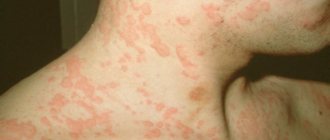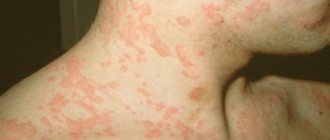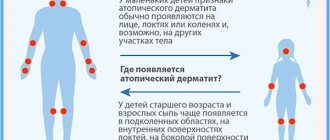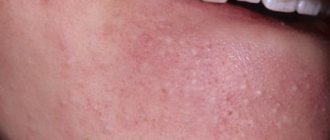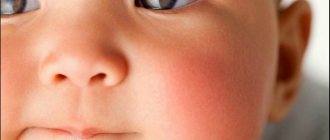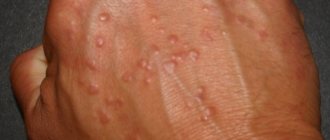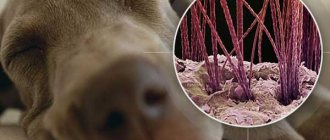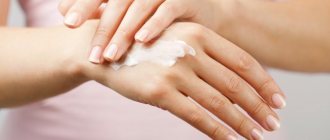Allergic manifestations on the skin of the hands are a pathological reaction of the body to temperature exposure. The causes of the disease have not yet been clarified. It is generally accepted that this feature appears due to the body’s hypersensitivity to its own protein, cryoglobulin, released at low temperatures. Manifestations similar to urticaria are usually observed in winter, but can also appear in summer, for example, after swimming in cold water. From the article you will learn what an allergy to cold looks like and how to deal with this problem. But what goose bumps look like on the arms above the elbow and what can be done about this problem is described in detail here.
Cold allergy is not an allergy at all
From a scientific point of view, this disease cannot be classified as allergies - there are no allergens in the body. But the reaction to cold is quite allergic. The main symptom of the disease is blisters in areas exposed to cold, which are very itchy. The rash can go away within a few minutes as soon as the person is in a warm room, or it can linger for a day.
But this is not the only symptom. The disease can be identified by several signs:
- The appearance of swelling on the lips and chilled areas.
- Runny nose and watery eyes.
- Sometimes allergies are accompanied by a cough.
- Severe itching, burning in cooled areas.
All this is caused not by allergens, but by the body’s individual reaction to cold. Frost damages the protective shell of mast cells, which are located deep in the epidermis. Histamine, a substance considered the main mediator of immediate allergic reactions, is released from damaged areas. It is this that causes all the redness, itching, and peeling of the skin.
Don’t swear at histamine in vain: it not only harms the body, but also plays a beneficial role in its vital activity - many metabolic processes occur in the body with the help of the substance.
Symptoms of pathology
Allergies in the hands to cold are often disguised as dermatitis. That is why it can be very difficult to distinguish it from this disease. An allergy to cold on the hands (see photo below) begins with simple scratching of the skin. Then your hands become dry. The skin on them becomes rough and covered with small cracks. Next, rashes like urticaria appear. After this, the hands swell.
In addition to hives, with its dense pinkish-red rashes, blisters may also appear on the skin. Their formation is accompanied by an unpleasant sensation of burning and itching. Most often, cold allergies on the hands resemble nettle burns, which, in fact, is why it got its second name.
The body may also exhibit more intense reactions. This occurs when cold rain or snow hits the surface of the skin. In this case, the hands become covered with red, swollen blisters filled with clear liquid. All these symptoms become pronounced immediately after warming the cooled areas of the skin. Then they gradually disappear, and after 30-60 minutes the skin becomes clear. In some cases, the rash lasts for a week, and sometimes longer.
Also, a person predisposed to allergies to cold begins to sneeze after going out into the cold. At the same time, he develops a runny nose. Such symptoms are associated with damage to the mucous membrane. All this causes difficulty in breathing.
The body's reaction to low temperatures sometimes manifests itself as an allergy to cold on the hands and eyes. At the same time, the organs of vision turn red, starting to tear and itch. At the same time, swelling of the area around the eyes and eyelids appears. It often becomes painful for a person to watch. He experiences pain in the eyes and other uncomfortable sensations, which intensify in bright daylight.
Cold allergies in the hands are also determined by some additional signs. These include:
- shortness of breath;
- headache;
- general malaise;
- pressure drops.
Such manifestations bring great discomfort to a person and contribute to the appearance of irritability, and also reduce performance.
Causes of cold allergy development
People predisposed to cold allergies have weak mast cells that are quickly damaged when exposed to temperature. Unreliable cell protection can be caused by two factors: genetics and diseases of internal organs (stomach, liver, intestines).
The disease manifests itself not only in winter, but also during cooling in summer, autumn and spring. For example, upon contact with cold water or ice. The areas of skin most susceptible to “allergies” are on the face, hands, inner thighs, calves, and knees.
Types and signs of the disease in adults and children
Cold urticaria can be:
- acquired;
- hereditary.
These are its main forms. The acquired form of urticaria appears 3-5 minutes after close contact with the allergen and lasts only 2-5 hours, then the symptoms disappear. Hereditary cold allergy manifests itself within a day or two after contact with the irritant and remains for 2-3 days.
With a hereditary type of urticaria, the main symptoms (skin) can be supplemented by systemic ones: fever, dizziness, shortness of breath, joint pain, weakness. Acquired urticaria is further divided into several subtypes:
- primary - symptoms appear within half an hour after contact with cold, the main signs are itching, redness, burning of the skin on the arms and legs, additional symptoms are also possible in the form of dizziness, rapid heartbeat, suffocation;
- slow - appears much later, the symptoms are the same as in the previous version;
- localized - the manifestation of a rash in the form of blisters only on that part of the body that was affected by the cold, maybe even on the lips after cold drinks;
- reflex – red spots appear in response to local contact of cold objects with the skin or to general hypothermia of the body;
- secondary – manifests itself after various infectious diseases.
Based on symptoms, cold urticaria is usually divided into the following subtypes:
- erythema (painful erythema forms on the skin after contact with an allergen);
- dermatitis (atypical cold form, swelling, redness, peeling of the skin);
- rhinitis (nasal congestion after cold air, called allergic rhinitis);
- conjunctivitis (eye irritation only outside in cold weather).
The classic signs of cold urticaria are:
- red blisters of various shapes and sizes on the area of the skin that was in contact with the cold, for example, on the outer thigh;
- swelling and pain in the hands during contact with cold objects;
- swelling of the lips and mucous membranes of the mouth when drinking cold drinks and after eating food with a low temperature.
If you press on allergic rashes caused by hives, they will temporarily turn pale. Rashes can appear anywhere, including on the feet, palms, and scalp. They are especially often localized on the face and neck. These areas are characterized by increased severity of symptoms. For a cold intolerance reaction to occur, a temperature below +3°C is sufficient.
In particularly severe situations, cold urticaria develops into anaphylactic shock and Quincke's edema (swelling of the larynx, tongue, and respiratory tract). These symptoms are deadly and require immediate medical attention. The most severe cold allergic reactions occur when the human body is completely immersed in ice water, for example, during traditional winter swimming. In such situations, a person can instantly lose consciousness and choke.
Eliminating cold allergy symptoms
- Of course, the main cure for cold allergies is warmth. If you find yourself experiencing symptoms of cold allergies, wrap yourself up even warmer. You don't have to wear five layers of clothing to do this. Replace synthetics with natural fabrics that protect heat. For example, for wool. Just don't wear wool on your naked body, as it can make your situation worse and damage your skin even more when it gets cold.
- Underwear and tights should also be made only from natural materials: cotton or flannel. A jacket or fur coat needs a deep hood, and your feet need high boots.
- Another effective remedy for allergies is protective creams with a large number of strengthening substances (for example, with allantoin, a chemical compound that stimulates tissue regeneration). Be sure to apply them before going outside: they will nourish the skin and protect it from the cold with a lipid film. Avoid cosmetics containing water. It will transform into ice crystals and cool the skin.
- We recommend that you try La-Cri protective cream for sensitive skin, which contains allantoin and several types of fatty oils with lots of vitamins.
Remember that all allergy protection measures are temporary, even if you use potent restorative and protective drugs. Eliminate the root cause of the problem, and the cold allergy will go away on its own.
Treatment
Treatment of cold urticaria always begins with stopping the patient's skin from contacting the irritant. It is necessary to wear warm clothes, swimming is allowed only in warm water, it is advisable to avoid cold food and drinks. Treatment of cold allergies on the hands requires wearing gloves or mittens.
To eliminate unpleasant symptoms, special medications are prescribed:
- Antihistamines - in solutions, gels and tablets (Fenistil, Zodak, Cetrin, etc.).
- Steroid drugs - hormonal drugs effectively block all manifestations of allergies and also have an anti-inflammatory effect. Both local and general therapy are carried out - ointment (for example, Advantan) is applied to the lesions; in severe cases, the medicine is administered intramuscularly.
- Bronchodilators are indicated when shortness of breath occurs and cyanosis appears. Preparations in the form of sprays (Salbutamol) provide a quick effect. In their absence, the drug is administered intravenously.
Clinical researches
A clinical study conducted by the company together with the Union of Pediatricians of Russia proves the high efficiency, safety and tolerability of products for daily skin care of children with mild and moderate forms of atopic dermatitis and during remission, accompanied by a decrease in the quality of life of patients. As a result of therapy, a decrease in the activity of the inflammatory process, a decrease in dryness, itching and flaking was noted.
It has been proven that La Cree cream for sensitive skin reduces itching and irritation, relieves redness of the skin, moisturizes and gently cares for it. The product is recommended by the Union of Pediatricians of Russia.
Consumer Reviews
ilmat about La Cree cream (otzovik.com)
“When we had such an embarrassment, we rubbed either diapers or walkers in the groin. Terrible redness and rashes in the form of small pimples began. I applied baby cream, but nothing helped, I bathed her in a series of baths. In the evening I bathe, in the morning it seems to be less, I apply baby cream and again there is this redness. I no longer knew what to do, I went to the pharmacy and at the pharmacy our pharmacist advised me to buy La Cree cream, it is just for relieving irritation, itching and redness of the skin. I bought it, came home, washed the baby, anointed it and the redness subsided a little later, in the evening before going to bed I anointed it and in the morning there were no more rashes, there was a little redness left, but it gradually went away.
Not much about the components:
- licorice extract
- bisabolol
- violet extract
- string extract
- walnut extract panthenol avocado oil.
La-Cri cream has a pronounced anti-inflammatory and anti-allergic effect.
Recommended for relieving local symptoms of allergic reactions - redness, itching, rashes and peeling. To relieve itching after insect bites.
The cream soothes irritated skin, moisturizes and smoothes it.
And what is probably the most important thing is that it DOES NOT CONTAIN HORMONES!
Approved for use in young children.
Indications
- diaper rash
- inflammatory manifestations on the skin in children
- 1st degree sun and thermal burns
- inflammation, itching, dry skin.
The only contraindication is individual intolerance.
Apply to dry skin 1-2 times a day.
Thank you for reading my review, maybe someone will need La Cree cream, it really helps.”
tan.-log (otzovik.com)
“I first came across the LA-KRI cream from Vertex when last year in the spring some rashes appeared on my daughter’s face, which seemed to me to be similar to lichen. In a panic, I turned to a dermatologist, but after all the tests, the doctor calmed me down, saying that it was just a skin infection that the child brought to his face with his hands. Salicylic alcohol 1% was prescribed; for decontamination and after wiping with alcohol, it was necessary to apply a layer of LA-KRI cream to the rash. At first I was wary of this product, but the doctor explained that this is a regular cream that contains oils of various herbs, softens the skin well and relieves redness and irritation.
In addition, I received the second piece of information at the pharmacy, when the pharmacist told me about the cream and noted that it was praised, although she warned me that before use it was necessary to check the allergy reaction by applying a little cream on the crook of the elbow for 5-10 minutes.
I’ll say right away that my child was not allergic to this cream. The treatment was scheduled for 7 days, but after 2-3 days of use, the spots on the face practically disappeared, and by the end of the treatment they disappeared completely...
...The color of the cream is brownish, like a foundation (when the cream is absorbed, a slight darkening remains on the skin, which is easily washed off with water), the smell can be said to be herbal (for an analogy, I can give an example: if you take grass and rub it in your hands, the smell slightly reminiscent of the smell of cream), the texture is light - the cream is quickly absorbed.
Area of application of the cream:
1. Diaper rash in children, and in adults too))) - easily copes with them
2. sunburn - personally tested - really brings relief
3. insect bites - relieves itching from mosquito bites (also tested on myself)
The consumption of the cream can be said to be economical. My family has been using a 30g tube for a year now and it’s not going to run out yet. I don’t remember the exact price, but I think it cost 120-130 rubles a year ago. Now a tube of LA-CREE cream is always in my medicine cabinet. Try it, you won’t regret it.”
Sources:
- B.A. Shamov, I.G. Safiullina, A.B. Beshimova, T.B. Shamov, Differential diagnosis of atopic dermatitis, journal of Practical Medicine, 2011 https://cyberleninka.ru/article/v/differentsialnaya-diagnostika-atopicheskogo-dermatita
- Fokina R.A., Atopic dermatitis: stages of development of classification forms, Siberian Medical Journal, 2007 https://cyberleninka.ru/article/v/atopicheskiy-dermatit-etapy-razvitiya-klassifikatsionnyh-form
- Schneiderman Paul, Grossman Mark, Differential diagnosis in dermatology. Atlas, Publishing house: Binom, 2017
- Reken Martin, Schaller Martin, Sattler Elke, Burgdorf Walter, Atlas of Dermatology, MEDpress-inform publishing house, 2018

